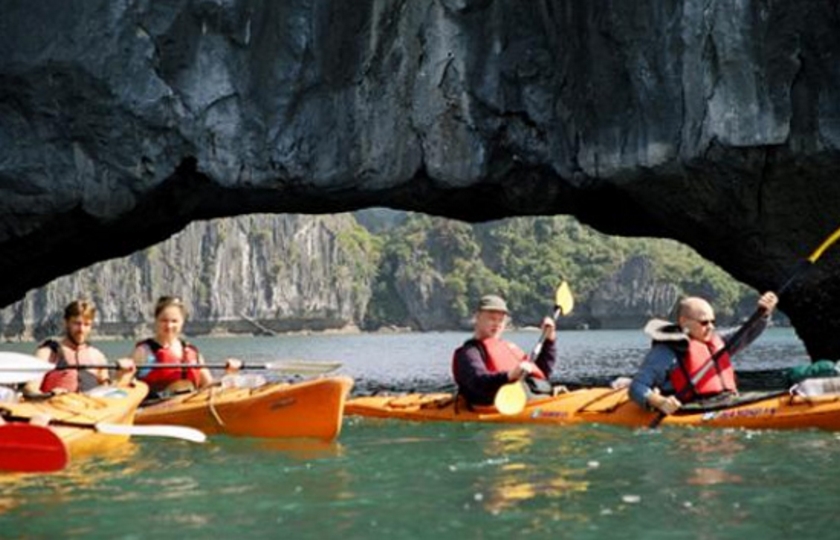Kayaking
Kayaking in Halong Bay - This is a small, relatively narrow, human-powered boat primarily designed to be manually propelled by means of a double blade paddle.
Kayaking in Halong Bay - This is a small, relatively narrow, human-powered boat primarily designed to be manually propelled by means of a double blade paddle.

Preparation
- Suitable clothes: T-shirt and short, swimming suit in the summer; warm clothes in the winter; wet shoes, hat, sunglasses
- Necessary things: Water, sun cream, dry bag, camera, insect repellent
- Life vests
Medical box and food
- Follow your tour guide: it is very important
- Listen to the route, time and rules
- Learn how to use the kayak even it is not your first time kayaking, wear the life vest and use the dry bag
- Strictly follow the leader (tour guide) about the moving rules
- Check with your tour guide the weather, tide and wind strength to have the best and safest route.
- Keep a suitable distance with the others, not too far, keep in sight with the others
- Keep away from the places which have strong flow, against the wind; take advantage of the wind strength and flow.
Children tips
- Follow the tour guide and their parents
- Sit still in the kayak, do not move in front of or behind
- Wear the life vest
- Wear the hat and sun cream
In case of unexpected situations
- Adjust the speed of the whole group if any of the member is out of sight
- In case the kayak capsizes, passengers need to swim a bit, and then take the water out of the kayak with the help of the tour guide. He will catch the kayak; take the water out by putting your kayak on his in the T- shape. After that, he will put the kayak back into the water; keep it still so that passengers can be on the kayak again.
- If there is an expected storm, find the safest place in the sheltered areas, beaches… to avoid the storm. In case passengers are in the middle of the sea and cannot find a safe place, passengers need to be gathered to make a raft
- If you are not sure about the route you are going, you should keep in touch with the others and paddle around the mountain, you will not be lost. Passengers should know for sure the route, search on the map.
- It is better if passengers have mobile phone, radio or any means of communication (often for professional kayakers

Preparation
- Suitable clothes: T-shirt and short, swimming suit in the summer; warm clothes in the winter; wet shoes, hat, sunglasses
- Necessary things: Water, sun cream, dry bag, camera, insect repellent
- Life vests
Medical box and food
- Follow your tour guide: it is very important
- Listen to the route, time and rules
- Learn how to use the kayak even it is not your first time kayaking, wear the life vest and use the dry bag
- Strictly follow the leader (tour guide) about the moving rules
- Check with your tour guide the weather, tide and wind strength to have the best and safest route.
- Keep a suitable distance with the others, not too far, keep in sight with the others
- Keep away from the places which have strong flow, against the wind; take advantage of the wind strength and flow.
Children tips
- Follow the tour guide and their parents
- Sit still in the kayak, do not move in front of or behind
- Wear the life vest
- Wear the hat and sun cream
In case of unexpected situations
- Adjust the speed of the whole group if any of the member is out of sight
- In case the kayak capsizes, passengers need to swim a bit, and then take the water out of the kayak with the help of the tour guide. He will catch the kayak; take the water out by putting your kayak on his in the T- shape. After that, he will put the kayak back into the water; keep it still so that passengers can be on the kayak again.
- If there is an expected storm, find the safest place in the sheltered areas, beaches… to avoid the storm. In case passengers are in the middle of the sea and cannot find a safe place, passengers need to be gathered to make a raft
- If you are not sure about the route you are going, you should keep in touch with the others and paddle around the mountain, you will not be lost. Passengers should know for sure the route, search on the map.
- It is better if passengers have mobile phone, radio or any means of communication (often for professional kayakers


.jpg)
.jpg)
.jpg)
.jpg)
.jpg)
.jpg)
.jpg)
.jpg)
.jpg)




